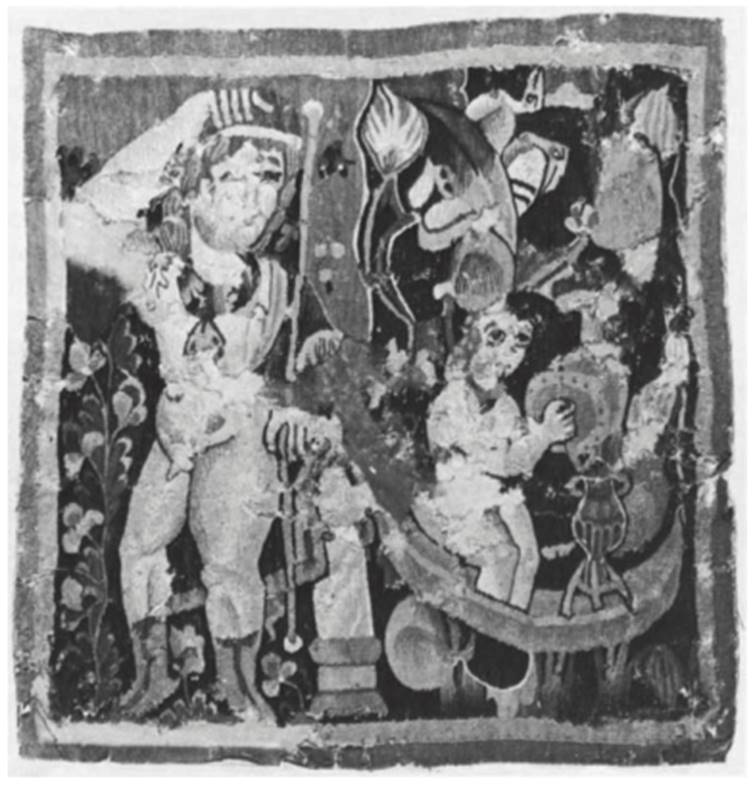Tapestry of Dionysos in Nilotic scene. Antinoe, Egypt, 4th-5th century. Colored wool on linen
This Egyptian textile is gorgeously enriched with red, pink, orange, blue, green, yellow, and light brown. Basically well preserved, the tapestry has sustained losses on the body, cape, and face of Dionysos, and part of the second body. The border neatly frames the scene in a self-sufficient composition, reminiscent both of mosaic emblemat and of large framed miniatures in illuminated codices.
Dominating the panel is the soft, easy figure of Dionysos, almost nude but for the gold-edged blue cape on his left shoulder, orange boots, a floral wreath about his neck, and a leafy diadem on his head; he holds a thyrsus, decked with flowers, in his left hand. The god appears relaxed, leaning on a column in a pose invented by Praxiteles in the fourth century b.c. This pose complements the mood of the floral background, seemingly a hymn to spring, dramatized by the clear red, which sets off the god's head and illuminates his act of crowning himself.

The right side of the panel, enlivened by plants, lotus blossoms, and birds, fluttering in spots of red, green, blue, and orange, recalls a very familiar and most ancient Egyptian motif, "Life along the Nile." A boat appears in this marshy world, carrying the figure of a nude child or young female, who holds cymbals and stands before a tripod bearing a vessel, perhaps a kantharos, traditionally associated with the Dionysiac ritual of the wine. The whole effect is joyous, an evocation of the Dionysiac appeal to the senses and, possibly, to his aspect as a reviving nature deity.
Textiles with Dionysiac subjects were enormously popular in late Roman Egypt, ranging from stereotyped, decorative ancillae to costume to independent images, like icons, intended for cult use. This panel fits into the latter category and may represent a conflation of the androgynous Greek god with the spring festival, localized in the Nile marshes. However, Picard-Schmitter (1962) has suggested that the scene represents a Hellenistic adaptation of the funeral rites of Osiris, the dying and resurrecting god whose rebirth heralds the coming of spring. Such an adaptation compares with the deliberate assimilation of Greek and Egyptian deities, achieved under Ptolemaic rule and exemplified by the composite god Sarapis (no. 171).
The town of АпЕпоё in Middle Egypt has been a major source of Egyptian textiles of the imperial period, but the dating of those textiles is an uncertain process. The Louvre has placed this panel in the sixth century. The rich palette, the extensive use of color modeling, and even shading in the two bodies, suggest, however, an earlier date, more in the direction of the Pan and Dionysos (no. 123) and the Nereid panel (no. 150), although certainly of finer, more subtle execution than no. 150. Indeed, the brilliant colors of this Nilotic scene resemble painted glass and may be compared with fragments of glass intarsia recently discovered at АпЕпоё and dated to about 400 (cf. Muller, 1962). The mixture of plastic and decorative forms, set within a doubled banded frame, seems closer to textiles and mosaics (Antioch) that have been dated to the fourth or fifth century. Bibliography: Picard-Schmitter, 1962, pp. 27-75; du Bour guet, 1964, no. B24; Paris, 1964, no. 170.
Date added: 2025-08-31; views: 73;
